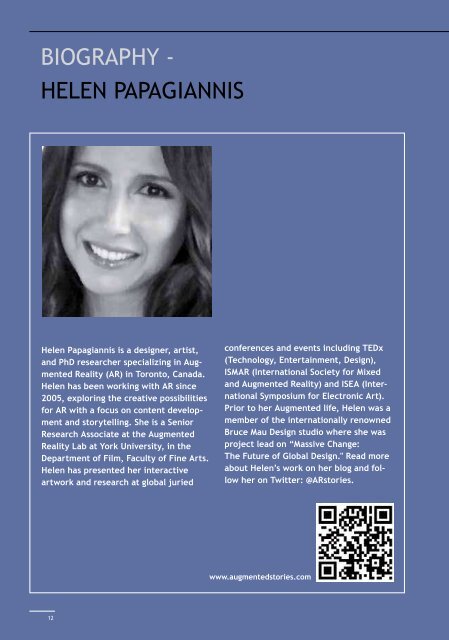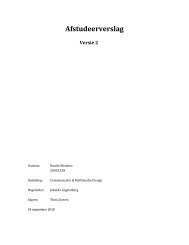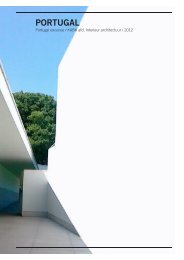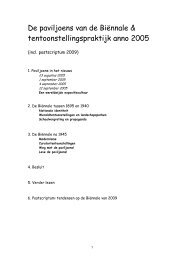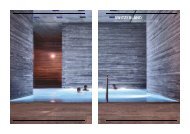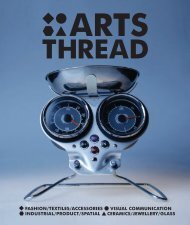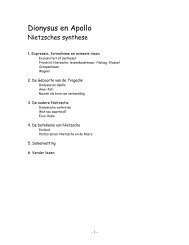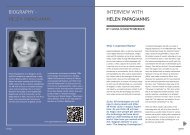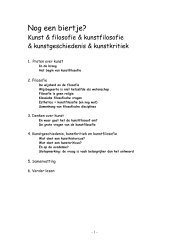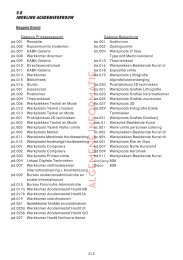download LR pdf - Kabk
download LR pdf - Kabk
download LR pdf - Kabk
Create successful ePaper yourself
Turn your PDF publications into a flip-book with our unique Google optimized e-Paper software.
Biography -Helen PapagiannisInterview withHelen PapagiannisBy Hanna SchraffenbergerHelen Papagiannis is a designer, artist,and PhD researcher specializing in AugmentedReality (AR) in Toronto, Canada.Helen has been working with AR since2005, exploring the creative possibilitiesfor AR with a focus on content developmentand storytelling. She is a SeniorResearch Associate at the AugmentedReality Lab at York University, in theDepartment of Film, Faculty of Fine Arts.Helen has presented her interactiveartwork and research at global juriedconferences and events including TEDx(Technology, Entertainment, Design),ISMAR (International Society for Mixedand Augmented Reality) and ISEA (InternationalSymposium for Electronic Art).Prior to her Augmented life, Helen was amember of the internationally renownedBruce Mau Design studio where she wasproject lead on “Massive Change:The Future of Global Design." Read moreabout Helen’s work on her blog and followher on Twitter: @ARstories.www.augmentedstories.comWhat is Augmented Reality?Augmented Reality (AR) is a real-time layering ofvirtual digital elements including text, images,video and 3D animations on top of our existingreality, made visible through AR enabled devicessuch as smart phones or tablets equipped witha camera. I often compare AR to cinema whenit was first new, for we are at a similar momentin AR’s evolution where there are currently noconventions or set aesthetics; this is a time ripewith possibilities for AR’s creative advancement.Like cinema when it first emerged, AR has commencedwith a focus on the technology withlittle consideration to content. AR content needsto catch up with AR technology. As a communityof designers, artists, researchers and commercialindustry, we need to advance content in ARand not stop with the technology, but look atwhat unique stories and utility AR can present.So far, AR technologies are stillnew to many people and oftenAR works cause a magical experience.Do you think AR will loseits magic once people get used tothe technology and have developedan understanding of how ARworks? How have you worked withthis ‘magical element’ in yourwork ‘The Amazing Cinemagician’?I wholeheartedly agree that AR can create amagical experience. In my TEDx 2010 talk, “HowDoes Wonderment Guide the Creative Process”(http://youtu.be/ScLgtkVTHDc), I discuss howAR enables a sense of wonder, allowing us to seeour environments anew. I often feel like a magicianwhen presenting demos of my AR work live;astonishment fills the eyes of the beholder questioning,“How did you do that?” So what happenswhen the magic trick is revealed, as you ask,when the illusion loses its novelty and becomeshabitual? In Virtual Art: Illusion to Immersion(2004), new media art-historian Oliver Graudiscusses how audiences are first overwhelmedby new and unaccustomed visual experiences,but later, once “habituation chips away at theillusion”, the new medium no longer possesses“the power to captivate” (p. 152). Grau writesthat at this stage the medium becomes “staleand the audience is hardened to its attemptsat illusion”; however, he notes, that it is at thisstage that “the observers are receptive to contentand media competence” (p. 152).When the initial wonder and novelty of thetechnology wear off, will it be then that AR isexplored as a possible media format for variouscontent and receive a wider public reception asa mass medium? Or is there an element of wonderthat need exist in the technology for it tobe effective and flourish?1213


